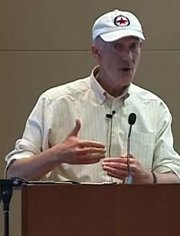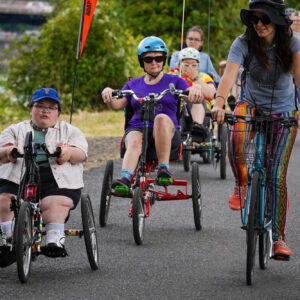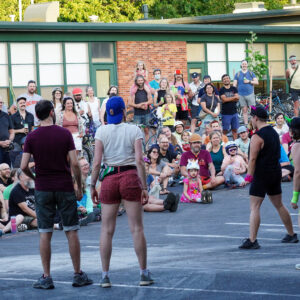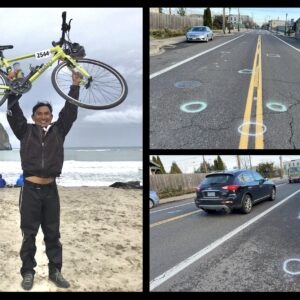
inspiring John Pucher.
(Photo: Still from video)
Remember John Pucher? He’s the Rutgers University scholar who shared his thoughts back in November about how to make cycling “irresistible”.
Now, the bubbly, bike-loving academic who signs his emails as “Carfree John” and who was dubbed “The Bicycle Scholar” by Momentum Magazine, is at it again.
He recently gave a presentation at Simon Fraser University in Vancouver (watch it below) that lays out an inspiring road map to increasing bike mode share in cities.
His basic premise? Make cycling safe and comfortable for everyone — not just the strong and hearty, lycra-clad set.
Pucher uses examples from the Netherlands, Denmark, Germany, and even a few cameos by Portland (like our bike-only signal) to make his case.
With our recent discussion of separation vs. integration of bike traffic and with our local and national momentum toward embracing bicycling as a viable means of transportation, I highly recommend this video…
— Link to the video presentation on the Simon Fraser website.






Thanks for reading.
BikePortland has served this community with independent community journalism since 2005. We rely on subscriptions from readers like you to survive. Your financial support is vital in keeping this valuable resource alive and well.
Please subscribe today to strengthen and expand our work.
Go John P ! This is the work that deserves exposure – it\’s going to take this message in concert/tandem with education, infrastructure, funding, enforcement, livestyle/inspiration and all of us strong riders to be inclusive and inviting to the mainstream pop \”interested but concerned\” to consider or reconsider the bike as a transportation tool. Speak the truth and shame the Devil, John… or something like that.
What Metal Cowboy said.
\”I\’ve never known anyone who went broke buying a bike\”
Ha. Maybe not one bike. But who is satisfied with one bike?
Great presentation, Pucher is hitting all the right nails (or notes?).
Key takeaway: \”people will cycle if you make it a practical, safe and feasible way to get around.\” Also some great observations about the (perceived) safety of cycling in the US/CAN vs Europe – which ties nicely to the discussion earlier this week, following the article in the Oregonian – and the proven potential of cycling as a mobility option for the elderly.
Very interesting. One major obstacle to getting more people on bikes is the fear inherent to many Americans. This is a fear that is grounded deep in the mindset of many Americans. Fear of letting your children play outside, fear of leaving your house or car unlocked, fear of terrorism, fear of inner city neighborhoods, etc. Better infrastructure will help some, but the American psyche at large must be changed. How to do that is enough for an entire book.
Peder Horner #5:
That\’s a common refrain, but I think it\’s like a lot of things – more media story narrative and less reality. Driving in traffic and having close calls with cars *is* frightening and it\’s rational to fear it. We\’ve watched the amount of cycling increase as the safe infrastructure does – as referenced in the video, the number of cycle trips has tripled as the infrastructure did. There\’s no reason to think it\’ll meet some critical juncture and just stop – it doesn\’t seem to elsewhere.
A long watch (80 minutes) but well worth it. I recommend downloading the video from the Simon Fraser site; more than once I had to restart the embedded video because I hit the arrow key (!)
I\’d love to see some footnotes sourcing Pucher\’s data. But his gist is that more bikes = safer cycling = yet more bikes, in a virtuous cycle. It\’s hard to argue with such a thesis when you have real-world examples of places like Northern Europe where almost no one wears lycra, wears a helmet, or rides a $3000 bicycle … and where everyone rides, not just young jocks in good physical shape.
He makes the very important point that Northern European cities made a conscious effort to increase the mode share of cycling in the 1970s. In the two decades previous they made the same kind of auto-oriented infrastructure decisions as American cities, but reversed themselves in the 1970s to their current benefit.
I\’m guilty of thinking that cycling is somehow \”just part of the culture\” in places like Copenhagen or Berlin, and that Europeans are \”just lucky\” to have a \”culture\” that promotes cycling. Pucher demonstrates to the contrary, the current bike-friendly climate there is the direct result of public policy and political action — not luck or history. Amsterdam didn\’t \”just happen.\” It was lobbied for, fought for, politicized, planned, legislated and implemented.
—
The last four minutes are full of thumpers (I\’m paraphrasing here):
\”For every hour you spend cycling, you add more than an hour to your lifespan.\”
\”When you figure in the time spent paying for a mode of transportation, cycling is the fastest form of transport.\”
(Most important, especially vis-a-vis recent discussions about political coalitions [e.g. with motorcyclists]:)
\”The success of bicycle programs depends on political success. You have to gain widespread public support for cycling as a mode of transport through coalitions, education, and outreach.\”
\”Motorists need to see themselves as part-time cyclists, too.\”
#7 \”Motorists need to see themselves as part-time cyclists, too.\”
Very true and that\’s where recreational cycling can play a huge part here in getting more people to empathize with cyclists and support cyclist-friendly policies, bike infrastructure, etc.
In all those European model countries, there is still a large majority of people who do most of their trips by car, but it\’s very hard to find anyone who doesn\’t ride a bike every now and then, either for getting around the neighborhood, for exercise or just for fun. In addition, with the drivers\’ age being 18, cycling is a very common mode of transportation for adolescents. So everyone is way more exposed to cycling, not just by sharing the road with cyclists, but also from personal experience riding a bike, even occassionally or when they were young.
And then of course they watch cycling on TV all spring and all summer…
Hi all,
I would like to get a transcript of this created – at least John Pucher\’s part.
I figure if we each take 5 minutes, then we can get it together pretty quickly.
I\’ll take the first 5 minutes. John\’s part of the video goes from about 0 to 1:18:40 (almost 80 minutes) — so that\’s 16 parts.
If you\’d like to participate, just drop me an email at the address here so I can make sure we don\’t have folks doing the same segments:
http://googlemapsbikethere.org/contact/
If you\’d like to get started asap, just leave a comment here and say, \”I got segment 2, 5-10 (minutes)\”.
When you\’re done, just email your text file and I\’ll put them all together.
It\’s a lot to ask, but I\’d like to have this done by Monday morning.
I\’ll probably put up a \’translation/status\’ page soon.
I would suggest you grab about five seconds on either side of your boundaries so we can link them up easily (so, start at 4:55 and go to 10:05).
I\’d suggest we put in some line breaks just to make reading it all easier – nothing literary/scientific necessary – just every 2-10 lines – whatever works, maybe there are some natural breaks with each slide – but you do _not_ have to worry about labeling your text with each slide, etc. – I just want the text written down so we can all use it, refer to it, etc.
As an earlier commenter suggested, you might want to download the .mov file to play from your hard drive, and I uploaded the video to Vimeo, but it\’ll take another couple of hours before it\’s ready:
http://vimeo.com/1096179
Here is just a visual representation of the translation I\’d like to see – I won\’t list your name or any contact info or anything like that, unless you\’d like to be publicly recognized, of course – by default, I\’ll assume your participation is to be kept private:
Segment # Time Period Translator
——— ———– ————
1 0:00- 5:00 Peter Smith
2
3
4
5
6
7
8
9
10
11
12
13
14
15
16
Thanks!
http://policy.rutgers.edu/faculty/pucher/
Some of the comments wanted reference material, footnotes, etc. in addition to watching Pucher\’s video presentation.
This link will take you to PDF documents of his recent presentations, with additional references included.
Clicking on \’Publications\’ will give you access to the same, but for his older material.
Well worth looking at.
Ron Richings
Vancouver, BC